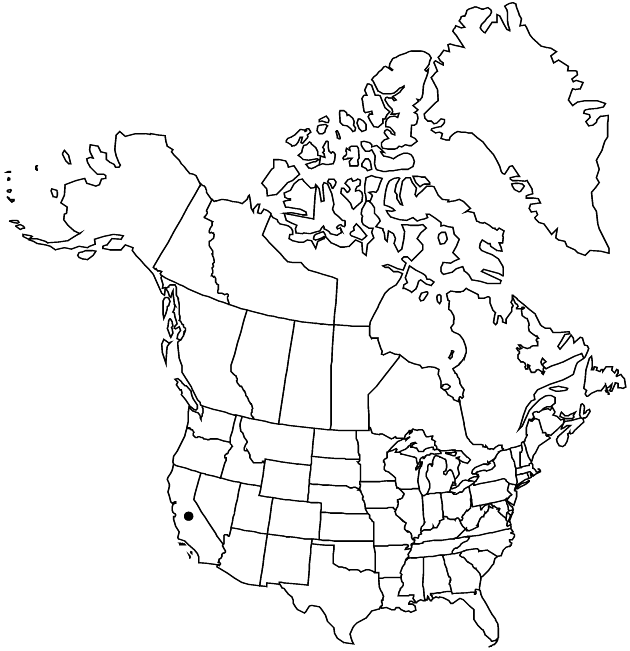Difference between revisions of "Layia hieracioides"
Bot. Beechey Voy., 358. 1839.
FNA>Volume Importer |
FNA>Volume Importer |
||
| Line 29: | Line 29: | ||
|elevation=0–1200 m | |elevation=0–1200 m | ||
|distribution=Calif. | |distribution=Calif. | ||
| − | |discussion=<p>Layia hieracioides occurs in the southern San Francisco Bay area, South Coast Ranges, and Western Transverse Ranges. Diploids and tetraploids are morphologically similar and reportedly geographically distinct, with diploids documented from the San Francisco Bay area and tetraploids (= L. paniculata) documented to the south. Natural, ± sterile hybrids between tetraploid plants and L. glandulosa have been documented from the Central Coast (B. D. Tanowitz and J. W. Adams 1986; R. F. Hoover 8369, UC).</p> | + | |discussion=<p><i>Layia hieracioides</i> occurs in the southern San Francisco Bay area, South Coast Ranges, and Western Transverse Ranges. Diploids and tetraploids are morphologically similar and reportedly geographically distinct, with diploids documented from the San Francisco Bay area and tetraploids (= L. paniculata) documented to the south. Natural, ± sterile hybrids between tetraploid plants and <i>L. glandulosa</i> have been documented from the Central Coast (B. D. Tanowitz and J. W. Adams 1986; R. F. Hoover 8369, UC).</p> |
|tables= | |tables= | ||
|references= | |references= | ||
| Line 53: | Line 53: | ||
|publication year=1839 | |publication year=1839 | ||
|special status= | |special status= | ||
| − | |source xml=https://jpend@bitbucket.org/aafc-mbb/fna-data-curation.git/src/ | + | |source xml=https://jpend@bitbucket.org/aafc-mbb/fna-data-curation.git/src/8f726806613d60c220dc4493de13607dd3150896/coarse_grained_fna_xml/V19-20-21/V21_659.xml |
|tribe=Asteraceae tribe Heliantheae | |tribe=Asteraceae tribe Heliantheae | ||
|subtribe=Asteraceae (tribe Heliantheae) subtribe Madiinae | |subtribe=Asteraceae (tribe Heliantheae) subtribe Madiinae | ||
Revision as of 15:36, 18 September 2019
Plants 5–130 cm (self-compatible); glandular, usually strongly sweet- or pungent-scented. Stems purple-streaked. Leaf blades elliptic, lanceolate, linear, or oblanceolate, 7–150 mm, margins (basal leaves) lobed to toothed. Involucres ± ellipsoid to obconic, 4–9 × 4–9+ mm. Phyllaries 6–16, apices shorter than folded bases. Paleae in 1 series between ray and disc florets. Ray florets 6–16; laminae yellow, 1–4 mm. Disc florets 9–80; corollas 2.5–4.5 mm; anthers ± dark purple. Ray cypselae glabrous. Disc pappi of 10–16 white to rufous or purplish, ± equal bristles or setiform scales 2–4 mm, each proximally plumose, not adaxially woolly. 2n = 16, 32.
Phenology: Flowering Apr–Jul.
Habitat: Open, often grassy, or semishady sites in chaparral, woodlands, forests, and coastal scrub, often sandy soils, disturbed sites
Elevation: 0–1200 m
Discussion
Layia hieracioides occurs in the southern San Francisco Bay area, South Coast Ranges, and Western Transverse Ranges. Diploids and tetraploids are morphologically similar and reportedly geographically distinct, with diploids documented from the San Francisco Bay area and tetraploids (= L. paniculata) documented to the south. Natural, ± sterile hybrids between tetraploid plants and L. glandulosa have been documented from the Central Coast (B. D. Tanowitz and J. W. Adams 1986; R. F. Hoover 8369, UC).
Selected References
None.
